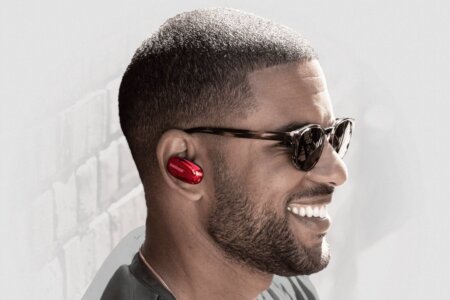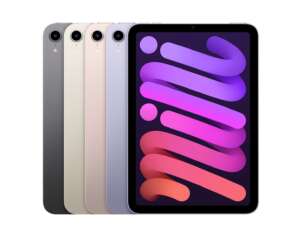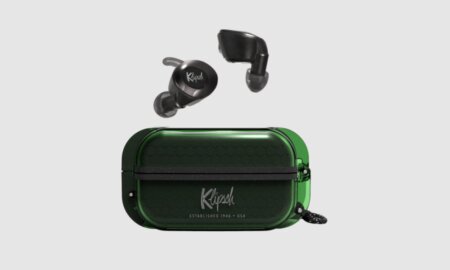This is a full review to compare and discusses the difference between the basic Apple iPhone 13 5G (left) and the iPhone 11 4G (right) smartphone, both of which are are non-pro versions.
Form Factor[tie_index]Form Factor[/tie_index]
| Tech Specs | iPhone 11 (4G) | iPhone 13 (5G) |
| Release Date | 20-Sep-19 | 14-Sep-21 |
| Form Factor | ||
| Size | 150.9 x 75.7 x 8.3 mm 5.94 x 2.98 x 0.33 in | 146.7 x 71.5 x 7.65 mm 5.78 x 2.81 x 0.30 in |
| Weight | 194 g (6.84 oz) | 173 g (6.10 oz) |
| IP Rating | IP68 (2m for 30mins) IEC standard 60529 | IP68 (6m for 30mins) IEC standard 60529 |
| Material | Front: Scratch-resistant glass. Back: Scratch-resistant glass. Frame: Aluminum | Front: Ceramic shield. Back: Textured matt glass Frame: Stainless steel |
| Colors | Black, White, Product Red, Green, Yellow, Purple | Product red, starlight, midnight, blue, pink |
Even though the iPhone 13 is slightly smaller, lighter, and thinner than the iPhone 11, it has the same display size of 6.1″.
Both phones appear to have the same IP Rating but the IP68 for iPhone 13 is certified to 6m for 30mins, same as the Pro series. On the other hand, the iPhone 11’s IP68 is certified to 2m for 20mins. We do not think the difference is important unless you plan to dive with the phone up to 6 meters deep.
Another advantage of the iPhone 13 is that it has a much durable, crack and scratch-resistant glass which Apple called the Ceramic Shield. We have an article on the results of the tests for Ceramic Shield and the Corning Gorilla Glass Victus used by other smartphones.
The iPhone 13 has a stainless steel frame design which is much more durable than the aluminum frame for iPhone 11. Overall, the size and material used for the iPhone 13 have a significant advantage over the iPhone 11.
Display[tie_index]Display[/tie_index]
| Tech Specs | iPhone 11 (4G) | iPhone 13 (5G) |
| Display | ||
| Screen Type | Liquid Retina HD display IPS LCD | Super Retina XDR OLED display |
| Screen Size | 6.1″ | 6.1″ (90.2cm2) |
| Resolution | 1792×828 pixels, 19.5:9 ratio, 326 ppi | 2532×1170 pixels, 19.5:9 ratio, 460 ppi |
| Brightness Max | 625 nits max brightness (typical) | 800 nits max brightness (typical); 1,200 nits max brightness (HDR) |
| Refresh Rate | 60Hz | 60 Hz |
| Screen-to-body | 79.00% | 86.0% |
| Contrast Ratio | 1400:1 | 2,000,000:1 |
| Colors | 10 bit, or > 1 billion colors | 10 bit, or > 1 billion colors |
| Color Gamut | Wide Color (P3) | Wide Color (P3) |
| Touch Sampling Rate | 120 Hz | At least 120 Hz |
| Features | True Tone Haptic Touch Fingerprint-resistant oleophobic coating Support for display of multiple languages and characters simultaneously | True Tone HDR display Haptic Touch Fingerprint-resistant oleophobic coating Support for display of multiple languages and characters simultaneously |
The iPhone 11 is probably the last Apple smartphone that still uses the Retina IPS LCD with only a 60 Hz refresh rate. The iPhone 13 display also has a refresh rate of 60Hz, and you will need to get the Pro series for the new ProMotion with a 120Hz adaptive refresh rate. The ProMotion display was already used by the iPad Pro series since 2017 for both the 11″ and 12.9″ models, albeit a lower brightness for the earliest model.
| iPhone 13 series’ XDR OLED display has a new feature called ProMotion, which refers to the same 120 Hz adaptive display that was first introduced with the iPad Pro. The higher frequency enables smoother scrolling and faster interaction while being adaptive helps to saves battery life. In the case of iPad Pro, the adaptive frequency also reduces Apple pencil latency of 20ms by half. |
The iPhone 13 also has increased brightness to 800 nits, HDR display, and a better contrast ratio.
Hardware and Sensors[tie_index]Hardware and Sensors[/tie_index]
| Tech Specs | iPhone 11 (4G) | iPhone 13 (5G) |
| Hardware & OS | ||
| OS | Apple iOS 13 to 15 | Apple iOS 15 |
| Chipset | A13 Bionic chip (7nm) 8-Core Neural Engine | A15 Bionic chip (5nm) New 16‑core Neural Engine |
| Processor | Hexa-core 2×2.65 GHz Lightning 4×1.8 GHz Thunder | New 6‑core CPU with two performance and four efficiency cores |
| GPU | Apple GPU (4 cores) | Apple GPU (4 cores) (new) |
| RAM/Storage | 4GB/64GB, 4GB/128GB, 4GB/256GB (NVMe) | 4GB/128GB, 4GB/256GB, 4GB/512GB (NVMe) |
| SIM Card | Dual SIM (Nano + eSIM) | Dual SIM (Nano + eSIM) Dual eSIM support |
| Speaker | Two, Stereo | Two, Stereo |
| Security | Face ID | Face ID |
| Sensors | Face ID Accelerometer Gyroscope Digital compass Ambient Light Sensor Proximity Sensor Barometer | Face ID Accelerometer Three-axis gyro Digital compass Ambient Light Sensor Proximity Sensor Barometer |
The most significant advantage of the iPhone 13 over the iPhone 11 is the A15 Bionic chip and 16-Core Neural Engine, which are two generations after the A13 on the iPhone 11. According to Apple’s tech specs, the 4-core GPU is “new”, meaning that it is different from the previous 4-core GPU used in iPhone 11.
The iPhone 13 has the same RAM but comes with a bigger storage option of 512 GB. It also supports the dual eSIM.
Battery Life[tie_index]Battery Life[/tie_index]
| Tech Specs | iPhone 11 (4G) | iPhone 13 (5G) |
| Battery | ||
| Capacity | 3110 mAh, non-removal. | 3,265 mAH. Non-removable. (12.41 Wh) |
| Type | Lithium-Ion | Lithium-Ion |
| Wired Charging | Fast charging 20W 50% in 30 min | Fast charging 20W 50% in 30 min |
| Wireless Charging | Qi charging up to 7.5W | MagSafe charging up to 15W Qi charging up to 7.5W |
| Reverse Wireless Charging | No | No |
| Charging Technology | PD 2.0 | PD 2.0 |
| Video playback | < 17 h (11h streaming) | < 19 h (15 h streaming) |
| Audio playback | < 65 h | < 75 h |
The new iPhone 13 has about 12-15% better battery life than iPhone 11 and supports twice as fast wireless charging via Magsafe. There are no improvements in charging speed as both phones use the same power delivery 2.0.
The slight increase in battery capacity of the iPhone 13 was not the cause of the longer battery life, but rather the more energy-efficient A15 Bionic processor. We believe the 120 Hz adaptive display also helps to save battery life.
Rear Camera[tie_index]Rear Camera[/tie_index]
| Tech Specs | iPhone 11 (4G) | iPhone 13 (5G) |
| Rear Camera | ||
| Resolution | 12 MP, f/1.8 (wide) 12 MP, f/2.4, 120˚ (ultrawide) | 12 MP, f/1.6 (wide) 12 MP, f/2.4, 120˚ (ultrawide) |
| Camera Features | – 2x optical zoom – Digital zoom up to 5x – Portrait mode with advanced bokeh and Depth Control – Portrait Lighting with six effects (Natural, Studio, Contour, – Stage, Stage Mono, High-Key Mono) – Optical image stabilisation (Wide) – Five‑element lens (Ultra Wide); six‑element lens (Wide) – Brighter True Tone flash with Slow Sync – Panorama (up to 63MP) – Sapphire crystal lens cover – 100% Focus Pixels (Wide) – Night mode (Wide) – Deep Fusion (Wide) – Next-generation Smart HDR for photos – Wide colour capture for photos and Live Photos – Advanced red‑eye correction – Auto image stabilisation – Burst mode – Photo geotagging – Image formats captured: HEIF and JPEG | -2x optical zoom out -Digital zoom up to 5x -Portrait mode with advanced bokeh and Depth Control -Portrait Lighting with six effects (Natural, Studio, Contour, Stage, Stage Mono, High-Key Mono) – Sensor‑shift optical image stabilisation (Wide) – Seven‑element lens (Wide); five‑element lens (Ultra Wide) – True Tone flash with Slow Sync – Panorama (up to 63MP) – Sapphire crystal lens cover – 100% Focus Pixels (Wide) – Night mode – Deep Fusion – Smart HDR 4 – Photographic Styles – Wide colour capture for photos and Live Photos – Lens correction (Ultra Wide) – Advanced red‑eye correction – Auto image stabilisation – Burst mode – Photo geotagging – Image formats captured: HEIF and JPEG |
| Video recording | 4K: 24/25/30/60fps 1080p: 25/30/60fps 720p: 30fps | 4K: 24/25/30/60fps 1080p: 25/30/60fps 720p: 30fps |
| Video Features: | – Extended dynamic range for video up to 60 fps – Optical image stabilisation for video (Wide) – 2x optical zoom out – Digital zoom up to 3x – Audio zoom – Brighter True Tone flash – QuickTake video – Slow-motion video support for 1080p at 120 fps or 240 fps – Time-lapse video with stabilisation – Cinematic video stabilisation (4K, 1080p and 720p) – Continuous autofocus video – Take 8MP still photos while recording 4K video – Playback zoom – Video formats recorded: HEVC and H.264 – Stereo recording | – Cinematic mode for recording videos with shallow depth of field (1080p at 30 fps) – HDR video recording with Dolby Vision up to 4K at 60 fps – Sensor-shift optical image stabilisation for video (Wide) – 2x optical zoom out – Digital zoom up to 3x – Audio zoom – True Tone flash – QuickTake video – Slow-motion video support for 1080p at 120 fps or 240 fps – Time-lapse video with stabilisation – Night mode Time-lapse – Cinematic video stabilisation (4K, 1080p and 720p) – Continuous autofocus video – Take 8MP still photos while recording 4K video – Playback zoom – Video formats recorded: HEVC and H.264 – Stereo recording |
There are several improvements to the iPhone 13 Pro Max rear camera summarized below.
- The wide and ultra-wide camera has a larger aperture than iPhone 11 Pro Max, which allows more light to the sensor.
- A comparison of the rear lenses size shows that the sensor for the iPhone 13 Pro Max could be larger. A larger sensor will help to capture more light and hence produce a better photograph. Currently, we do not have any specifications of the sensor used in the iPhone 13 Pro Max.
- There are also several new features for the rear camera as highlighted in blue, which will greatly enhance the photos and videos taken.
One of the most significant features that are advertised is the new cinematic mode, which is also featured in Xiaomi’s smartphone. This will be a good feature for those who like to take videos for social media posting. Everyone can become a professional videographer.
Front Camera[tie_index]Front Camera[/tie_index]
| Tech Specs | iPhone 11 (4G) | iPhone 13 (5G) |
| Connectivity | ||
| Bluetooth Ver | 5.0, A2DP, LE | 5.0, A2DP, LE |
| Wi-Fi Ver | Wi-Fi 802.11 a/b/g/n/ac/ax dual-band, hotspot. | Wi-Fi 802.11 a/b/g/n/ac/ax dual-band, hotspot. |
| Connector | Lightning | Lightning |
| GPS | Built‑in GPS, GLONASS, Galileo | Built‑in GPS, GLONASS, Galileo, QZSS and BeiDou |
| NFC | Yes with reader mode | Yes with reader mode |
| Infra-Red Port | No | No |
| Network | 4G LTE, HSPA, GSM | 5G, 4G LTE, HSPA, GSM |
The key specifications of the front camera hardware did not change much but Apple added a lot of features for the Selfie camera. The number of new features shows the emphasis on the front camera as one of the most popular components of the smartphone. Among the new features that are noteworthy include the smart HDR mode, time-lapse, and night mode.
The new night mode for selfies is used to capture better photos when the camera automatically detects a low-light environment.
Another neat feature is the “QuickTake video” which allows video capturing by pressing the shutter button longer when taking a photo. This is a new feature of the selfie camera but it was already used for the rear camera in the previous iPhone X or later.
Connectivity and Environment
| Tech Specs | iPhone 11 (4G) | iPhone 13 (5G) |
| Connectivity | ||
| Bluetooth Ver | 5.0, A2DP, LE | 5.0, A2DP, LE |
| Wi-Fi Ver | Wi-Fi 802.11 a/b/g/n/ac/ax dual-band, hotspot. | Wi-Fi 802.11 a/b/g/n/ac/ax dual-band, hotspot. |
| Connector | Lightning | Lightning |
| GPS | Built‑in GPS, GLONASS, Galileo | Built‑in GPS, GLONASS, Galileo, QZSS and BeiDou |
| NFC | Yes with reader mode | Yes with reader mode |
| Infra-Red Port | No | No |
| Network | 4G LTE, HSPA, GSM | 5G, 4G LTE, HSPA, GSM |
Last but not least, we already mentioned at the beginning that iPhone 13 is a 5G phone which is the most prominent reason to upgrade from the iPhone 11. The BeiDou is the Chinese version of the “GPS”, which is touted to provide better accuracy in China and the Asia-Pacific. The QZSS is Japan‘s own satellite positioning system.






